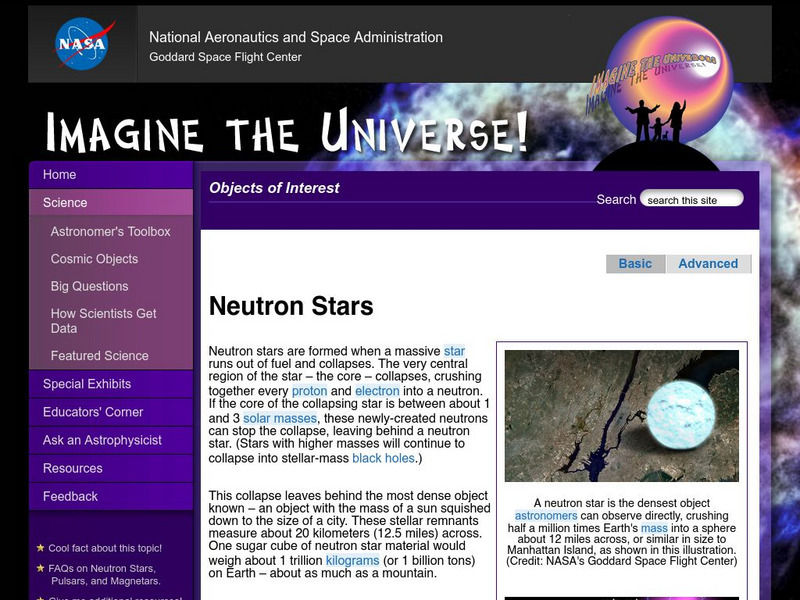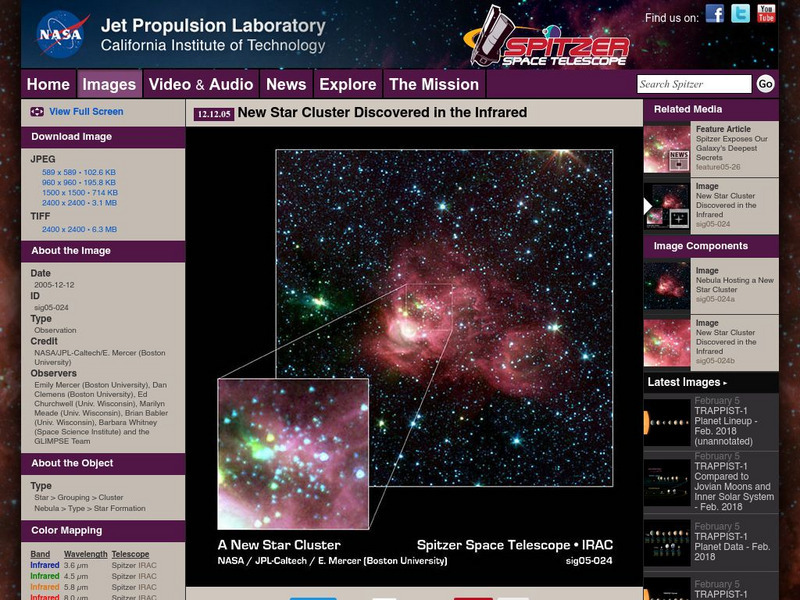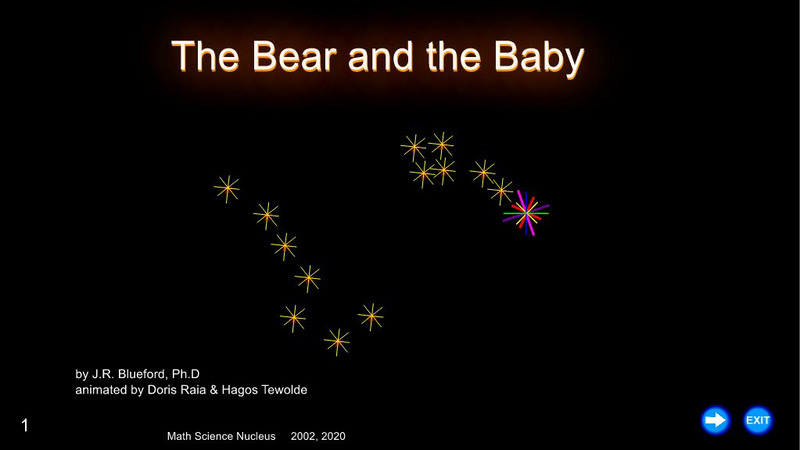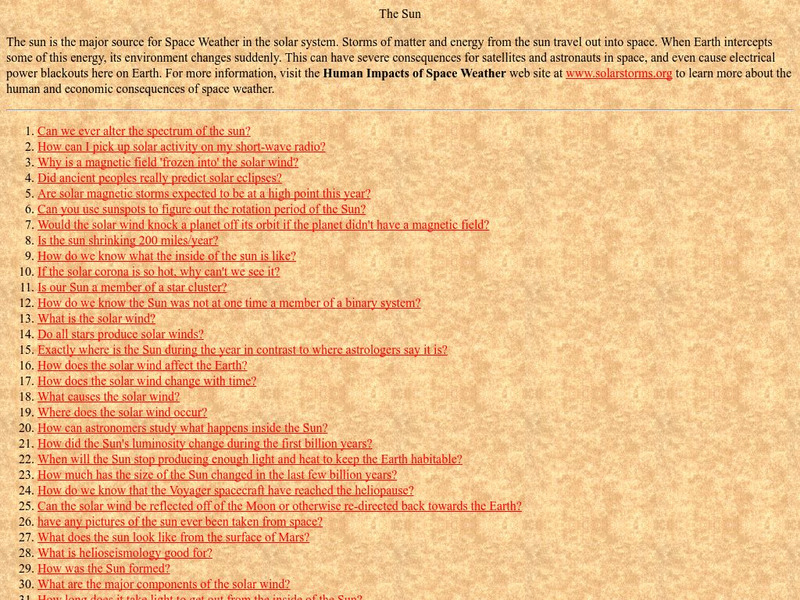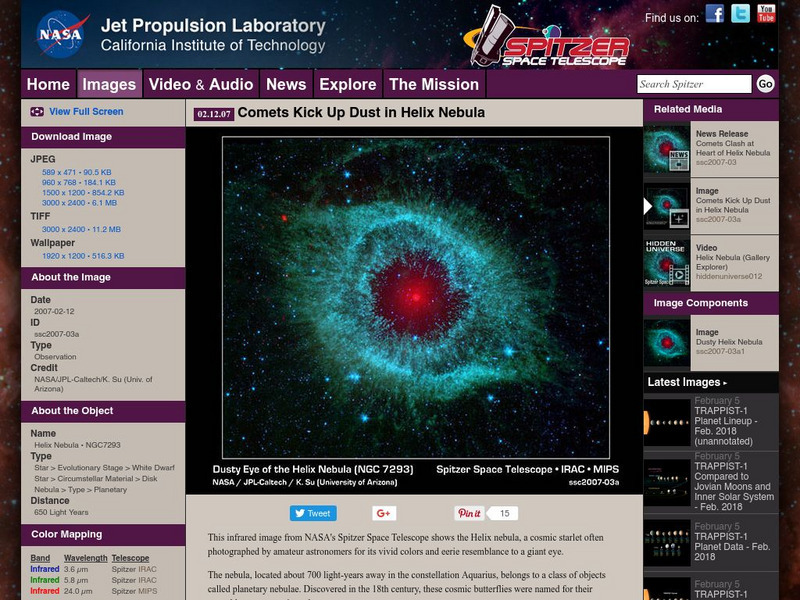E-learning for Kids
E Learning for Kids: Science: Antarctica/ What Are the Different Parts of the Universe?
In this lesson, students learn about objects in the universe, including constellations, planets, meteors, asteroids, and comets.
Other
Denver Museum of Nature and Science:telling Time at Night Using Big Dipper [Pdf]
Students examine how to tell time by using the stars and arithmetic. Some topics explored are the Big Dipper, the North Star, and the Little Dipper.
Ducksters
Ducksters: Astronomy for Kids: Constellations
Kids learn about the constellations in the science of astronomy. These stars that form patterns when viewed from the Earth have been studied since ancient times.
NASA
Nasa: Imagine the Universe: Neutron Stars and Pulsars
Discover what neutron stars and pulsars are and view pictures of them. Includes links to additional resources and lesson plans.
Mocomi & Anibrain Digital Technologies
Mocomi: What Is a Constellation?
Constellations are patterns formed by groups of stars. Take a look at some of the familiar constellations.
NASA
Nasa: Imagine the Universe: X Ray Binary Stars
Site provides a brief introduction to binary stars. Additional resources for students and teachers on this topic are offered as well as related topics.
California Institute of Technology
Spitzer Science Center: A New Star Cluster
The image entitled, "A New Star Cluster" shows the formation of a new group of stars located in the Milky Way galaxy. The text below the image goes into detail on describing the various specifics of the image.
NASA
Nasa: Spitzer Science Center: Story of Stellar Birth
Under the heading, "Story of Stellar Birth" this site examines specific details of an image displaying the apparent life cycles of young stars in the Cepheus constellation.
Math Science Nucleus
Math Science Nucleus: The Bear and the Baby
This animation discusses the history of the constellations and the naming according to myths. The specific constellation dealt with in this animation is Ursa Major and Ursa Minor (the bear and the baby).
California Institute of Technology
Spitzer Science Center: Orion's Inner Beauty
Under the heading, "Orion's Inner Beauty" this site examines specific details of an image displaying the Orion nebula, which is stated to be "our closest massive star-making factory."
NASA
Nasa: Image Science Center: Ask the Space Scientist
A NASA space scientist provides 98 questions and answers about the sun, the center of our solar system.
Other
Hong Kong Space Museum
Besides an introduction to exhibitions and events at the museum, the site provides a guide to stargazing, an astronomy FAQ, space news, virtual tours (see site map) and research resources (including Chinese-English star and constellation...
California Institute of Technology
Spitzer Science Center: Red Giant Image
This image features two views of the "bow shock" of a dying star in the Hydra Constellation. The text below the image proceeds to explain a "bow shock" in relation to the red giant star pictured.
California Institute of Technology
Spitzer Science Center: Helix Nebula
Under the heading, "Comets Kick up Dust in Helix Nebula" this site a particular nebula in the constellation Aquarius. In addition to an image, the site provides information on nebulas and star systems.
Massachusetts Institute of Technology
Mit: Open Course Ware: Hands on Astronomy: Observing Stars and Planets
A university-level course in basic observational procedures in astronomy. Covers how to use a telescope, and includes lecture notes.
Other
Astromador: Astronomia Para Amadores
This resources focuses exclusively on astronomy. It's packed with historical facts about space exploration, famous people who pioneered the study of stars and planets. It features chronological list of space exploration, current news,...
British Library
British Library: International Dunhuang Project: Chinese Astronomy Resource
Using the early Dunhuang Star Atlas, an important historical and scientific document of the sky seen from China dating from before AD 700, learn about astronomical history from the perspective of China. Find resources and analysis that...
American Museum of Natural History
American Museum of Natural History: Carl Sagan and the Quest for Life in the Universe
A brief biography of American astronomer and science advocate Carl Sagan.
Other
Paper Plate Education: Serving the Universe on a Paper Plate
Excellent resource for "paper-plate" activities that help simplify various astronomy topics. Learn how to build a "Moon Finder" and "Planet Pointer," and create a paper-plate model that explains the Transit of Venus.



![Denver Museum of Nature and Science:telling Time at Night Using Big Dipper [Pdf] Activity Denver Museum of Nature and Science:telling Time at Night Using Big Dipper [Pdf] Activity](https://d15y2dacu3jp90.cloudfront.net/images/attachment_defaults/resource/large/FPO-knovation.png)

